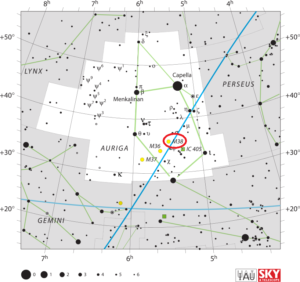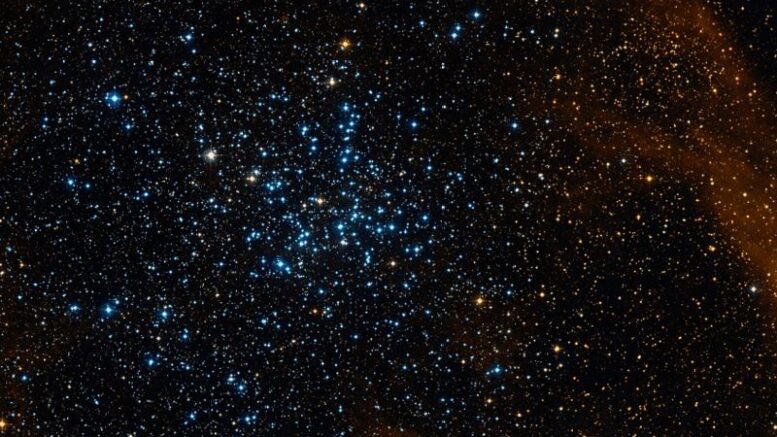Messier 38 (M38), also known as the Starfish Cluster, is an open star cluster located in the northern constellation Auriga. The best way to observe Messier 38 is in small or medium-sized telescopes at low magnifications and the best time of year to observe the cluster is during the winter months, when Auriga rises high for northern observers.
| Description | |
| Visible From Pacific Northwest | November to April |
| Best Time To Observe | January |
| Minimum Size Of Viewing Device | 10×50 binoculars |
| Object Type | Open Cluster |
| Designations | Messier 38, M38, NGC 1912, Collinder 67, OCl 433.0, C 0525+358, MWSC 0557 |
| Right Ascension | 05h 28m 42s |
| Declination | +35°51’18” |
| Constellation | Auriga |
| Age | 220 million years |
| Apparent magnitude | +7.4 |
| Apparent dimensions | 21′ |
| Object Radius | 25 light years |
| Distance From Earth | 4,200 light years |
History
Messier 38 was first discovered by the Italian astronomer Giovanni Battista Hodierna before 1654, at the same time that he discovered the nearby clusters Messier 36 and Messier 37. Guillaume Le Gentil found the clusters M36 and M38 independently in 1749. Charles Messier included M38 in his catalogue on September 25, 1764.
Locating M38 In The Sky
Messier 38 is relatively easy to find because it is located within the polygon formed by the brightest stars of Auriga. The northern point of the polygon is marked by Capella, Alpha Aurigae, the third brightest star in the northern celestial hemisphere. M38 can be found roughly two thirds of the distance from Capella to the bright Elnath (El Nath), the second brightest star in Taurus constellation, which lies to the south of Capella.
Alternatively, the cluster can be located by first finding Messier 36, which lies just to the west of the midpoint between Mahasim, Theta Aurigae, and Elnath, Beta Tauri. Mahasim is the second star going anti-clockwise from Capella in Auriga‘s polygon. Messier 38 lies 2.3 degrees to the northwest of Messier 36. Messier 37, the third Messier cluster in Auriga, can be found a further 4 degrees to the southeast of Messier 36. Messier 38 is the dimmest of the three open clusters.

Viewing M38
Messier 38 appears quite large in 10×50 binoculars and binoculars with larger magnification resolve some of the cluster’s stars. 4-inch telescopes show many of the cluster’s stars, mainly concentrated toward the central region and forming an irregular pattern that has been compared to the Greek letter Pi, an irregular arrow and an oblique cross. The cluster’s X shape is even easier to make out in 8-inch telescopes, which reveal stars across the cluster, many of them arranged in pairs.
Photographing M38
Photographing the Starfish Galaxy shows how the galaxy got its nickname as M38 looks like a starfish when imaged. There are several different ways to image Messier 38 as it is a popular target. There seems to be not much time required for exposure required to image Messier 38, with accurate guidance required for crisp images of the stars.
Sources And Further Reading
Descriptions of all of Messier Objects can be found here.
https://freestarcharts.com/messier-38
https://www.galactic-hunter.com/post/__m38

Be the first to comment on "Messier 38 Starfish Cluster"